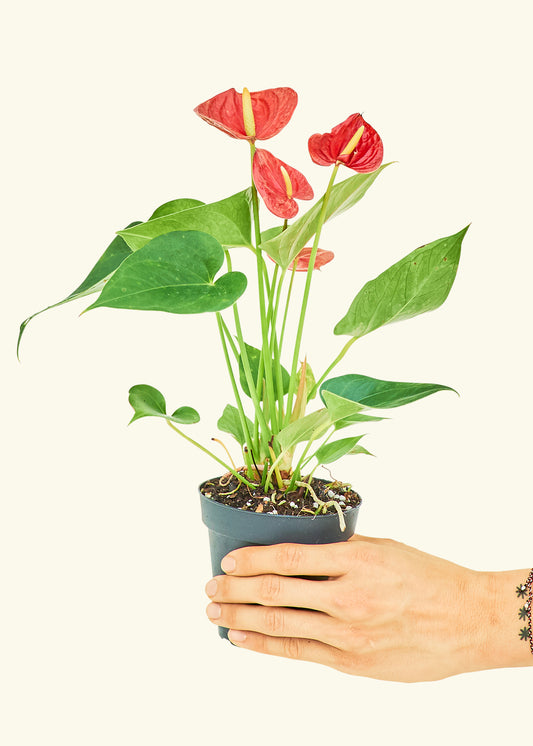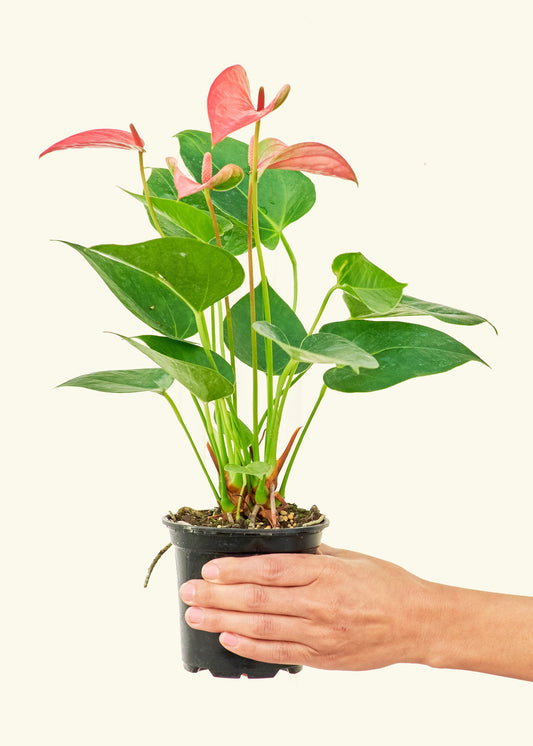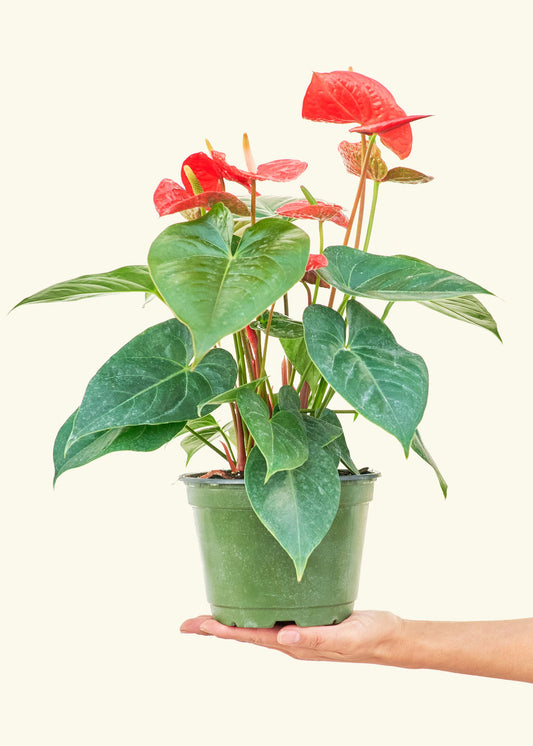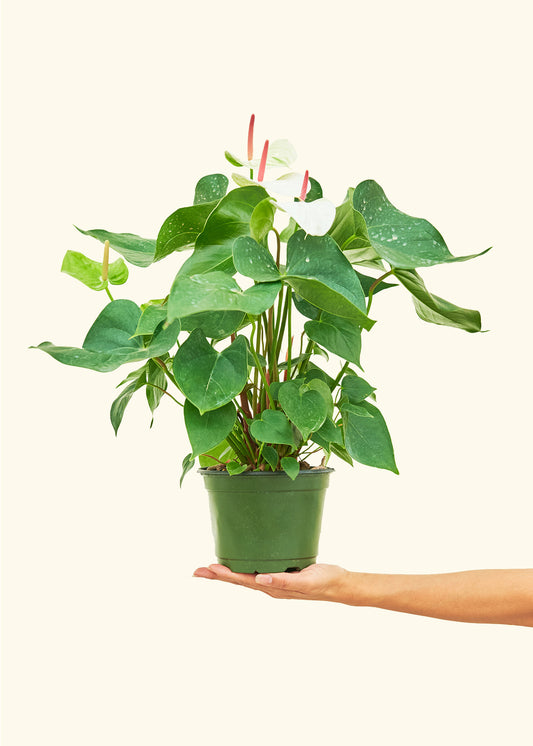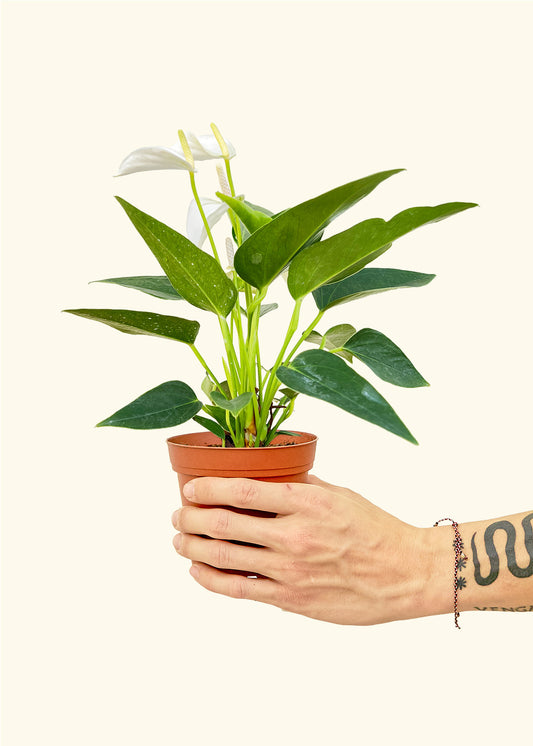Anthuriums: Overview
Bring a burst of color and elegance to your home with Anthuriums, one of the most striking tropical houseplants available. Known as the Flamingo Flower or Flamingo Lily, these vibrant plants are loved for their glossy, heart-shaped leaves and long-lasting, waxy blooms that stand out year-round.
Native to the rainforests of Central and South America, Anthurium plants thrive indoors when given the right conditions. While they’re relatively easy to maintain, proper Anthurium plant care is key to keeping them healthy and blooming. These plants symbolize hospitality, abundance, and love, making them a meaningful gift as well as a stylish decor choice.
It’s worth noting that Anthuriums are considered toxic if ingested by pets or people, so placement is important. With their tropical beauty, symbolic meaning, and air-purifying qualities, Anthuriums are more than just plants. They’re living works of art that elevate any room.
Anthurium Plant Benefits
- Adds bold, tropical color to any indoor space with its glossy leaves and striking flowers.
- Long-lasting blooms make Anthurium plants ideal for year-round decoration.
- Symbolizes hospitality, love, and abundance, making it a thoughtful gift.
- Helps improve indoor air quality by filtering certain toxins from the air.
- Versatile placement options, thriving in living rooms, offices, and shaded patios.
Anthuriums Care: Growing Guide
With the right approach, Anthuriums reward you with lush foliage and stunning blooms throughout the year. While they’re not overly demanding, learning the essentials of Anthurium plant care will keep your Flamingo Flower thriving indoors.
Watering, Light, Humidity, and Temperature
Anthuriums prefer consistently moist soil, but they dislike sitting in water. Bright, indirect light keeps the plant blooming without scorching its leaves. They thrive in higher humidity levels and prefer temperatures between 65–80°F, making them perfect for warm, indoor environments.
Reporting, Soil, and Feeding
Repot Anthuriums every two to three years to refresh their growing medium and allow room for new roots. Use a light, well-draining potting mix rich in organic matter. Feed with a balanced, water-soluble fertilizer monthly during the growing season to support blooms.
Propagation
Anthuriums are commonly propagated through division. Gently separate mature plants at the root level, ensuring each section has healthy roots and leaves. Repot the divisions in fresh soil, water well, and keep them in a warm, humid environment until established.
Pruning, Cleaning, and Common Issues
Remove faded blooms and yellowing leaves to encourage fresh growth and maintain the plant’s appearance. Wipe the leaves regularly to remove dust and keep them glossy. Watch for pests like aphids and mealybugs, and avoid overwatering to prevent root rot and leaf yellowing.
Anthurium Plants: Choose From Our Collection
Our Anthurium collection offers a variety of colors to brighten any space, each with the same striking, glossy leaves and elegant blooms. Whether you prefer reds, soft pinks, or crisp whites, these Flamingo Flower plants add tropical charm indoors.
Pink Anthurium
Description: The Pink Anthurium (Anthurium andraeanum) features delicate, rosy-hued spathes paired with deep green, heart-shaped leaves. This beautiful pink plant boasts a soft yet vibrant color that brings a touch of elegance and romance, making it a perfect choice for gifting or brightening up living spaces.
Red Anthurium
Description: Known for its classic, bold appearance, the Red Anthurium (Anthurium andraeanum) showcases vibrant scarlet blooms that last for weeks. This variety symbolizes hospitality and love, making it one of the most popular Flamingo Lily plants for homes and offices.
White Anthurium
Description: The White Anthurium (Anthurium andraeanum) offers a sophisticated, timeless look with its crisp white flowers contrasted by glossy green foliage. Its serene beauty makes it ideal for minimalist interiors, weddings, and as a statement piece in modern spaces. It’s also a popular sympathy plant.
Shop for Anthuriums for Sale at Hey Rooted Now!

